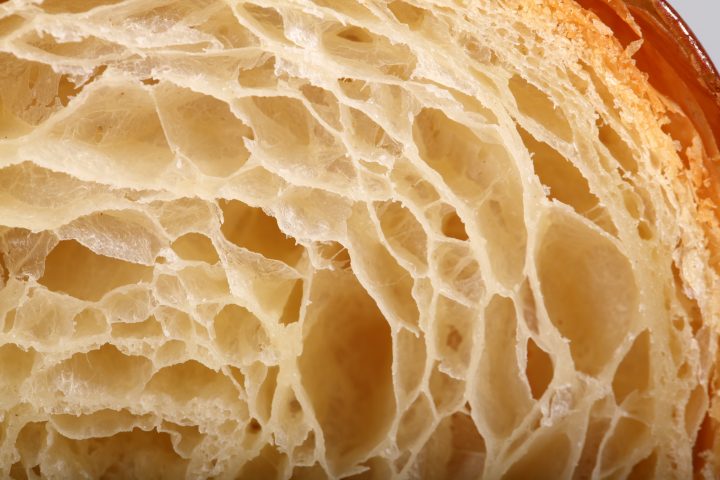
Baking croissants is always a work in progress, hopefully these answers are useful if you are up for the croissant baking challenge…
A lot of (first time) croissant bakers ask pretty much the same questions when tackling this challenging pastry. We composed a list of the top questions with our answers. Pretty sure your question will be answered here. Now lets get to the point of your very valid questions!
GENERAL RECIPE QUESTIONS
Why is your version a three day recipe?
The three day croissant recipe schedule is done for the right planning of the whole process so you can make your croissants on the third day in the morning, but of course you can take less time if this fits your timing better. Take a look at our one day version of this recipe too.
I am a first time croissant baker. What is your best advice?
Choose a cold day with a room temperature below 20 ºC / 68 ºF for your first attempt. This way you will have more time for the whole process and less chance of butter being absorbed by the dough. The key is to keep the butter solid between the layers of dough, this is what gives the croissant its flakiness.
My first attempt croissants look nothing like the ones in your pictures! What did I do wrong?
Do not expect to get perfect croissants the very first time you try to make croissants, most people need to make them 3 to 4 times to get the general feeling for the process. There is no substitute for practice and experience. There is no way to hide little mistakes in your technique when making croissants, so work very precise and follow the instructions to the letter. One small mistake is no problem but several small mistakes add up!
My croissants have a bread-like crumb and no layers. What did I do wrong?
Several factors can be the cause of this. Most likely it is an accumulation of things going sideways. It starts with pressing too hard on the dough to try and lengthen it while it is already fighting back. Keeping at this for a while means, next to the pressing on the dough, you are taking too long and the butter starts to get warm and is absorbed by the dough. So in this case, while still learning and getting better and faster, until you do make sure you build in extra fridge time to cool the dough and then continue. Handle the dough with care, gently elongate without pressing too much or putting your weight into it.
Can I turn your croissant recipe into a sourdough version?
We would recommend finding a recipe that is already a worked out version for sourdough croissants. We are not really a fan of the sour taste in pastry and for that reason we do not have enough experience to guide you to a good enough result.
Can you provide the measurements as ml, tsp, cups, instead of grams for all the ingredients?
We very much recommend weighing your ingredients. Professional bakers use scales (also in the US) and in Europe home bakers do too. A scale will give you the exact same weight every time. Which is absolutely needed if you consistently want to make good bread and especially good pastry. You can get a scale for the same price as a few sacks of good flour and less than a lot of baking tools you already own, so if possible, go and get one!
What are the measurements if I only want to make half of your recipe?
If you halve the recipe, the dough square should be 18.4 x 18.4 cm and the butter slab 12 x 12 cm.
Put the butter slab on top of the dough square and wrap the butter.
Roll the dough into a 20 cm x 30 cm rectangle.
Fold letter style to a 20 cm x 10 cm rectangle.
Turn dough 90 degrees.
Roll from the short 10cm side to a 20cm x 30cm rectangle (the short 10cm side will get 30cm).
Turn dough 90 degrees.
Roll from the short 10cm side to a 20cm x 30cm rectangle (the short 10cm side will get 30cm).
Turn dough 90 degrees.
Roll from the short 10cm side to a 20cm a 55cm rectangle (the short 10cm side will get 55cm).
The size of the final dough, right before cutting, should be 20 x 55 cm.
Although it is possible to use halve the dough we advise to make the full recipe as described in the recipe as the geometry of the shapes are much easier to work with.
You can always use halve and freeze the other halve.
I want to bake croissants, but live in a tropical location. Can I still make them?
We have gotten tips from people who have successfully baked croissants in the tropics. The top tips:
Cool ingredients and even utensils in the fridge before use, and use the fridge a lot to cool your dough and cool for longer if needed.
Roll the dough at night, when it is cooler. Check the weather reports and choose the coolest period possible.
BUTTER
My butter breaks into pieces. What should I do?
We use organic butter with a high fat content and low water content (about 82% fat). A higher water content tends to make butter hard, which promotes tearing and breaking and ruins the layers. Your butter needs to be pliable and at the same time not too soft at the moment of usage.
Help, butter leaks out when baking!
Your croissants were probably under-proofed. Just let them proof a bit longer so they get wobbly and increase visually in size. When under-proofed the butter tends to leak out from in between the layers and you end up with a butter puddle.
There’s so much butter in these croissants! Can I use less?
We would suggest making the recipe with the amount of butter indicated, enjoy the croissants and just try to eat less instead of a less than buttery croissant.
Next day eat soup and a salad.
FLOUR
Can I use another type of flour than the French type 55 you use?
For a good croissant you need the right type of flour. We have tried at least 5 different types and brands before we found a winner. If you cannot get the type 55 French flour try to find a flour with around 11% protein (this can be an all purpose / plain flour) and make sure it is a good quality flour. Try different brands if needed or use a combination of flours. Using 100% bread flour can make your result ‘heavy’ so try a combination with all purpose for instance.
DOUGH
My dough was too moist and sticky to handle. What should I change?
First of all it seems your flour absorbs less moisture than the type 55 flour we are using and you need to make adjustments by using a little less moisture next time.
My dough resists and shrinks back when I try to roll it out. What can I do?
At any stage when the rolling of the dough gets harder you can cover the dough and let the gluten relax for 10 to 20 minutes in the fridge before continuing.
If you keep on pressing the dough, trying to roll it while it resists, you will damage the layers!
SHAPING, PROOFING & YEAST
Can I use fresh yeast instead of instant yeast?
Yes you can. Use three times the amount given (so for our recipe 33 grams of fresh yeast).
Can I use active dry yeast instead of instant yeast?
Yes you can. Use 1.2 times the amount given (so for our recipe 13.2 grams active dry yeast).
At what stage should I add filling to my croissants?
You add filling just before the shaping / rolling up stage. Be aware that any filling will affect the layers and you will need less filling than you probably think. With chocolate for instance you will need no more than 5 to 7 grams per croissant. Professional bakers use stick chocolate for this, but you can use your own good quality (dark) chocolate. Fillings like jams are often added (injected) after baking.
I want to shape my croissants like a crescent. Why are your croissant not crescent shaped?
According to Raymond Calvel croissants laminated with margarine are formed into the crescent shape, while croissants laminated with butter are left in the straight form. We say, use whichever shape you like best, but do use real (organic) butter!
My croissants do not puff up like yours. What should I do?
First check the ‘sell by’ date on your packet of yeast and see if it is still OK to use it. Also make sure the temperature of your dough and proofing environment are correct.
Ideally you should proof the croissants draft-free at a temperature of 24ºC to 26.5ºC / 76ºF to 79ºF
BAKING
Why are my croissants under/over cooked?
Check the true temperature of your oven and see if any adjustments need to be made there. See our tips on the subject: Bread baking tips: Making the most of your oven.
Why are there pools of butter at the bottom of my baking pan when baking the croissants?
This could be a result of under-proofing, so make sure you proof at the right temperature and take the time to proof to perfection and get that nice wobble in your dough. It could also be you were not as meticulous as needed during the lamination process, so stick to the measurements, make sure they are as exact as possible, the edges are straight and follow our laminating instructions carefully.
Help my croissants split open during baking! What did you do wrong?
We suspect your croissants lack real layering and therefor are more bread-like with a lot of butter incorporated. Because they have this substance and are under-proofed and lack layering, you get an oven-spring during baking and the bread splits at its weakest points. With correct layering you get air pockets which will be able to expand and not rupture.
So try to work on your layering by keeping the laminated dough cool, work fast and do not press on the dough when rolling it but gently elongate it.
I want to freeze my croissants and bake at a later stage. What is the best way to do this?
Check out our tips for retarding and freezing with the one day version of our croissant recipe.
You can always find a way to adjust the recipe to fit your schedule.
What do I do to keep baked croissants fresh?
We would advice to put the croissants you do not eat on baking day in the freezer, after they have cooled. For extra flakiness and ‘almost as good as freshly baked’ you can put them into an oven for about 8 minutes at 175°C / 345°F, straight from the freezer.










Evelyn lanzalotti says
I noticed that the yeast is not mixed with sugar in a 100 degrees F to let it form a foam
David Allyn says
In addition to explaining WHY something happens, it would be helpful, as you have done with most questions, to explain WHAT to do if the problem arises. If there isn’t an answer, say so.
Stephanie says
Hi there, the recipe on your site says refrigerate for 30 minutes in between folds, but your YouTube video says freeze for 20 minutes in between folds. Which one is it?
I followed your recipe on the website (refrigerate for 30 minutes). Just finished the last fold, and I’m pretty sure all that time and money is down the drain.
Noora says
I tried so many recipes, but this recipe was perfect for me.. I made butifull croissants from first time trial.. Thank you very much for your tips and schedule ❤️❤️
Noriko says
Hi. My croissant dough look very good when it was proofing and outside looks perfect when baked but when I cut it it was a huge air pocket in the middle. Very thin top and bottom. Is this because under proof or lamination problem?
Randi says
Hello! I am wondering if there may be a typo in your directions for the third day, croissant shaping. It says to “cut a notch in the middle of the short end of the triangle…” I watched the video and it seems that this notch is cut in the long base of the triangle. So I just wanted to ask to be sure…..
Thank you!
Randi
Janice Stetler says
Can you use salted butter for the laminating step? And to compensate, decrease the salt added to the dough?
Gennelle says
My croissants are well browned on the outside, but the inside is undercooked. What should I do?
Dr Richa Sahu says
Hii .. would you mind to tell me,why my Crossiants got distorted while final proofing…
Eva says
Hoi!
Ik ben ontzettend fan van de weekend bakery website en ik heb dit recept de afgelopen jaren al vaak gemaakt. Ik heb veel goede resultaten gehad maar nog niet zo perfect als die van jullie! Mijn croissants zakken bij het rijzen een beetje uit waardoor ze bij het bakken zeker voor de helft plat worden op de bakplaat. Hebben jullie een idee hoe ik dit kan voorkomen?
Alvast heel erg bedankt!
Groetjes Eva
Nicholas says
Hi, first time tryin out your recipe. I’m on day 1, just finished kneading my dough over an hour ago, covered in wrap and left it in the fridge. Is the dough supposed to proof during its time in the fridge overnight? Cuz mines is proofing. Do i simply punch out whatever gas it has created the morning after and then continue with the recipe?
Aiko says
Yes, it will proof in the fridge. When you roll the dough out when laminating it, you can gently push the rolling pin from top to down on the dough before rolling the entire dough. That should push out most of the air coming from the proofing.
Anne says
I forgot to first proof my croissant dough, instead, placed it directly in the fridge, what shall I do to save it?
Aiko says
It should be completely fine as long as you leave the dough in the fridge over night.
Vonda K says
Just make sure during your final proof befor baking, you dont forget to let it get fully to the slight wobble stage along with the egg wash.
Natalia says
Hi! I made them a second time and were amazing but I’m having troubles with the butter. When I’m laminating I can see pieces of butter through the dough even at the last minute but the butter its 84% fat and really manageable. I don’t know what I’m doing wrong. Thanks so much and I’m sorry for bother!
Aiko says
Hi, when the butter shattered, it’s very possible that the butter is too cold.
In order to get the best result, we usually look for the same texture/softness across the dough and the butter.
From my experience, putting the dough in the freezer between doing the folds usually makes the butter becomes too hard and thus shattered easily during the laminated process. Leaving the dough in the fridge (not the freezer) for 30 mins usually gives a better consistency between butter and the dough.
Hope this help!
Vonda K says
Aiko is correct, but you can use the freezer but not longer than 10 to 15 per stint, that also applies during the time of year and how warm you kitchen is.
Natalia says
thanks a lot to u too! we are in summer now, but normally isnt more than 22° celsius, but I’m trying doing what u and Aiko told me…so excited to try again doing this
Natalia says
thanks so much! this helps me a lot…next time I’m doing to do this
Caroline says
Is there a way to safely store the croissant dough in freezer for a week plus? After the three letter folds before actually cutting into croissant shapes?
Aiko says
Yes! You can safely store the unbaked croissants in the freezer for a couple weeks, but in general, most of the chef will recommend you shape them first and then freeze it.
In that case, when you are ready to bake the croissant, you only need to take them out from the freezer to the fridge the day before, and then on the baking day, take it out of the fridge for 30-60 mins so that it goes back to the room temp, and then following the proofing instruction from the recipe.
The fully proof croissants should feel giggly, when you touch it, it’s like infant’s cheeks 🙂
Freeze the laminated but not yet shaped croissant is not recommended. Since it might make it hard for you to get the laminated dough back to the proper temperature to roll out and shape.
Hope this help.
apple says
hi, what cause the air pockets in the dough ? and how to fix it ?
Aiko says
What kind of air pocket are you talking about? Is it in the dough? Or is it in between the layers? (between the dough and the butter?)
If it’s in the dough, it’s cause by the natural proofing process, and if it’s between the dough and the butter, it’s likely that you fold in the air when wrapping the dough around the butter or doing the fold.
Caroline says
Have you ever baked croissants with a deck oven? What were your results?
Jessica says
I’m following your instructions exactly…but my croissants are coming out of the oven very tiny! Like 10cm long. This is after 2hrs proofing at 25.5 degrees C. What’s going wrong? Do I need a longer proof?
Jessica says
Sorry, another question. I am in British Columbia, Canada, and AP flour is the “regular” flour here. I wonder could I use Italian Type 00 flour in this recipe, for some or all of the quantity of flour? I’ve made the recipe twice, and aside from the croissants coming out small, they have a dense, “doughy” centre. Would 00 flour help with this?
Weekend Bakers says
Hello Jessica,
We think there might be something the matter with the true temperature of your oven. It is very important to check this first.
This is how you can check this (see the first tip):
www.weekendbakery.com/posts…your-oven/
Yes generally speaking you can use the type 00 flour for the croissants. There is a longer story to be told, because the protein content and type of wheat can vary with this flour, but the one available in Canada should be the right type to use for this too.
Jessica says
Thank you for your quick response! 🙂
I have an oven thermometer, and have been baking them at 400F–I’m actually finding the croissants are burning pretty quickly at that temperature, in addition to having virtually no ‘oven spring’. Note: my oven is electric.
Jas says
Hi
I would admit that i deviated the proofing time from 2 hours to 3.5 hours..by then the dough sunk back with the butter leaking..
That was totally my bad..
But my doubt is; does my oven have to have a fan for baking them?
I felt the temp was not evenly distributed..
Help me..
Weekend Bakers says
Hello Jas,
Yes that ‘sounds’ definitely like over-proofing. If possible we would use the fan oven for baking croissants, but if it is not up to the task and you get an uneven result we would sooner try the conventional setting and see how that goes. If there are ‘hot spots’ in your oven you could should first of all look at the placing of the goods on the tray and in the oven and also turn the tray after you are sure the croissants are stable.
Neda says
Hi thanks for perfect information.
Why My croissant flatten in oven?
Weekend Bakers says
Hello Neda,
The most common reason would be under-proofing. They need more time to develop. If you first see expansion and then they collapse in the oven then that is a sign they were under-proofed. Give them more time to develop good layers and structure.
Naa says
I’ve trying homemade croissants with very little success, my major challenge is the butter breaking during rolling.
My butter and dough has the same consistency from the beginning ensuring that there is no broken butter but after chilling the whole dough, and rolling during my final turn, the butter breaks!
What could be the cause?.please advice.
Weekend Bakers says
Hello Naa,
Please make sure your butter has the right high fat content of at least 82% and that it is pliable. If the butter breaks easy, try and find another brand or quality butter if possible. Also leave the dough for a few extra minutes if you think the dough / butter is a bit too cold after chilling or chill for a shorter period.
Good luck with it!
Jass rafael says
Why my croissant when i proofing it will cracking the dough up and dough?
Weekend Bakers says
Sorry, we do not exactly understand your question?
Natalia says
Hi! I’m really excited to try the 3 day recipe, but I have a question. It’s ok if I follow de day 1 and 2 schedule and the 3rd day I move it to the afternoon? Its going to be more than 24 hrs in the fridge but I can’t have 3 free mornings and don’t want to ruin them….thanks so much in advance and so sorry for bother u!! greetings from Chile!
Weekend Bakers says
Hello Natalia,
Yes, if your fridge is cold enough (around 5 to 6 C) then this should be alright. If you want to practice and do not have much time you can try the one day recipe too:
www.weekendbakery.com/posts…nt-recipe/
Good luck with it!
Natalia says
thanks so much for your answer! normally my fridge is 2 or 3° C so I’m excited to try this!
Natalia says
I made them and turn out delicious! thanks so much , they are the best croissants I tried in my city <3 and I hope the next time will be even better
Weekend Bakers says
Thank you Natalia, so happy to get your feedback and you can enjoy wonderful home made croissants!
Devdatt Godbole says
I am trying Croissants the third time using dry yeast and used salted butter.
1-Using salted butter will make a difference as compared to using unsalted butter?
2-The upper surface of the croissants is a bit hard and not flaky and crispy. What could be the reason? Is it because I am baking them at 230Deg cel for 8 mins and then lowering the temperature to 180deg cel in Oven?
Weekend Bakers says
Hello Devdatt,
Using salted butter only makes a difference for the saltiness /taste of the end product. It can also (slightly, depending on the amount) slow down yeast activity. We would use less added salt when using salted butter.
We are not sure about you second question, it depends how close the top of the croissants is to the heating elements, maybe choose a lower tier if possible.
Vivienne says
I just love your recipe- tried a few others and although similar yours worked beautifully. Your advice to try them three times before altering was good advice. Will no never go back to buying them- thank you so much! Delicious. Vivienne (Australia)
Weekend Bakers says
Thank you so much Vivienne, so glad our advice proofed to be good 🙂
Enjoy your pastry baking!
Francesca Wilson says
Hi! Would I be able to double this recipe? If so what would the dimensions be?
Weekend Bakers says
We would suggest after the initial dough making you divide the batch in halve and do two separate batches as described, this way you will keep workable dimensions.
Kei says
While kneading the dough with butter in it, the dough teared apart and butter came out! It’s now a mushy buttery dough. Please help! Can I still save this dough?
Weekend Bakers says
Hello Kei,
Without seeing it we cautiously suggest you might want to start again..
Das says
When we cook our croissant then we see some croissants are opened! Why opened it??
We use t45 flour! Please suggest me soon as possible!
Weekend Bakers says
Question: Help my croissants split open during baking! What did you do wrong?
We suspect your croissants lack real layering and therefor are more bread-like with a lot of butter incorporated. Because they have this substance and are under-proofed and lack layering, you get an oven-spring during baking and the bread splits at its weakest points. With correct layering you get air pockets which will be able to expand and not rupture.
So try to work on your layering by keeping the laminated dough cool, work fast and do not press on the dough when rolling it but gently elongate it.
Good luck with your next bake
Nikki says
Hi, I followed your recipe and got some really good lamination on my croissants (and pain au chocolat). However, despite being flaky and brown on top, there were areas of uncooked dough inside the croissants. I put them back in the oven for an extra 7 minutes to try and cook out the centre a bit more, but sadly, still very doughy. What did I do wrong please? Delicious recipe though!
Weekend Bakers says
Hi Nikki,
Again, we think this could be an oven problem.
Check the true temperature of your oven and see if any adjustments need to be made there. See our tips on the subject: www.weekendbakery.com/posts…your-oven/
If it turns out your oven loses a lot of heat during opening and when putting in a lot of cold dough in a smaller oven for instance, start out at a higher temp to compensate.
Next to this make sure you proofed the croissants long enough.
Good luck with it!
Faith says
Hi,
I’m just wondering how do you make the layers light and airy like in the pictures? I’ve tried your recipe four times now, but although my croissants have a lot of layers, the layers are compact and heavy.
Thanks!
Weekend Bakers says
Hello Faith,
We guess it could be the type of flour you use, maybe in combination with not enough proofing time. Also check if your oven is hot enough, maybe start out a little higher and temper when you reach the right color.
Hope you will continue!
Adam says
Hello, I have tried your recipe with halved the portion but I got a bit of confusion on the measurement.
After wrapping the butter with the dough I would get an about 15x15cm square and then I would roll it into a 20x30cm rectangular. A fold would then yield a 20x10cm rectangular then a 90 degree turn would mean that I would be facing the ‘open’ end 10cm and this following step I got confused.
Your recipe says “the 10cm side will get 30cm”. Shouldn’t be the 20cm side become 30cm and the 10cm become 20cm when I roll the dough towards myself? To get the 10cm side to be 30cm, I should be rolling the dough sideways? Or I could have been misunderstood something?
Weekend Bakers says
Hello Adam,
Maybe it is a good idea to watch the video and see how the dough is rolled out and turned www.weekendbakery.com/posts…roissants/. It can be confusing to talk about how the dough is rolled without actually seeing it. With each turn, after the fridge time, you also rotate the dough.
You can also rotate your dough 180 degrees to keep it more even, because you tend to use more pressure when rolling away from you than towards yourself. You can use these techniques during all the rolling steps of this recipe.
Jessica says
Hello!
I’m a tired Mumma and accidentally rolled the dough out 4 times instead of the 3, before going into the refrigerator. Will this completely ruin my croissants?
Weekend Bakers says
Hello Jessica,
This will make a difference, you will get (much) more layers, it will potentially not ruin your croissants, but this is also depends very much on your laminating skills. The layers are more delicate, so it is harder to get it right.
Hope it was still good enough to be able to enjoy your pastry.
Still, thumbs up for attacking this challenging bake while juggling family live!
Moises Saavedra Jr. says
Is it ok to use all purpose flour in this recipe
Weekend Bakers says
Hello Moises,
Yes, that is OK if this is your best or only option. More people use this with good result. Sometimes it also pays to try different brands of AP flour or maybe an organic variety, because it can make a difference.
Nadeema says
Hi, made my very first croissant, the texture and taste is perfect however there is no defined lamination on the outside also not flaky. What did I do wrong?
Kind regards
Nadeema
Weekend Bakers says
Hello Nadeema,
You did nothing wrong we think. It is just the practice and experience you need. Like we say above : Most people need to make them 3 to 4 times to get the general feeling for the process. There is no substitute for practice and experience. There is no way to hide little mistakes in your technique when making croissants, so work very precise and follow the instructions to the letter. One small mistake is no problem but several small mistakes add up!
Also, when you start to work quicker, less butter gets absorbed in the dough, giving better lamination.
Enjoy the process!
Cristina says
I tried this recipe recently and I have to say its the closest I’ve gotten to my “ideal croissant” 🙂 I can see the lamination is correct and I have a honeycomb structure interior but I’m finding that the crumb is still quite tight. I would like to achieve a more hole-y, lacey honeycomb so they are lighter. What are the factors that affect this? am I not achieving enough rise during the final proof stage?
Weekend Bakers says
Hello Cristina,
Thank you that sounds wonderful!
For an even better result try to perfect (and possibly speed up with experience) your laminating process, control and measure the proofing and also try different flours to see if this makes a difference in the end result.
Enjoy the process!
CL says
Hi, thank you for the very detailed recipe! ☺ I have a question though. Why do other recipes
require elongating the dough to 60 then 110cm (like yours) while others don’t, although these recipes use almost the same amount of ingredient? What is the purpose of elongating it to 110 cm at the end? I’m finding it really hard to elongate it to 110cm and was wondering if it makes a lot of difference if I stretch the dough to shorter lengths. Thank you! 🙂
Weekend Bakers says
Hello CL,
We do not know these recipes that do not elongate but in general it is just a question of amounts and measurements and thickness of the dough. Make sure you have the right type of flour and gluten development to make the rolling part as effortless as possible and when the dough resists leave it to relax for a few minutes (if needed let it relax in the fridge). If the dough ends up being not exactly 110 cm but closer to 100 that is no problem, but it should not be 60 cm, it will be too thick to get a good result.